6.3: Inverse Trigonometric Functions
( \newcommand{\kernel}{\mathrm{null}\,}\)
In previous sections, we have evaluated the trigonometric functions at various angles, but at times we need to know what angle would yield a specific sine, cosine, or tangent value. For this, we need inverse functions. Recall that for a one-to-one function, if f(a)=b, then an inverse function would satisfy f−1(b)=a.
You probably are already recognizing an issue – that the sine, cosine, and tangent functions are not one-to-one functions. To define an inverse of these functions, we will need to restrict the domain of these functions to yield a new function that is one-to-one. We choose a domain for each function that includes the angle zero.
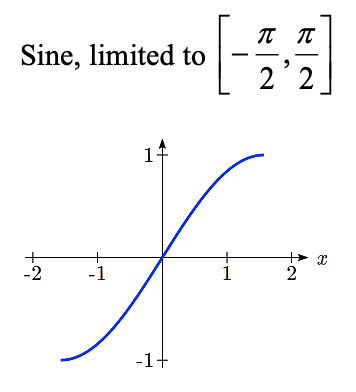
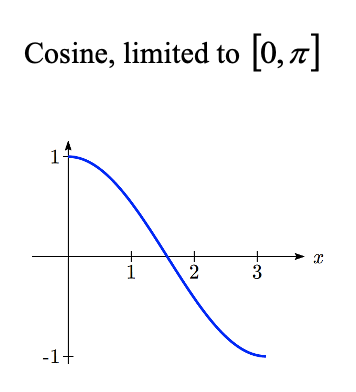
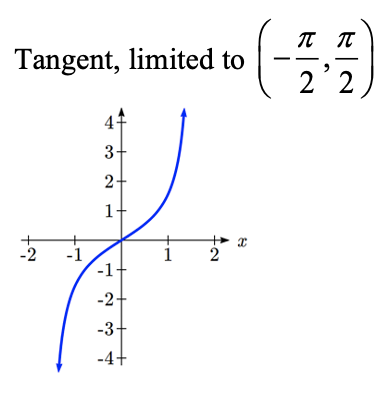
On these restricted domains, we can define the inverse sine, inverse cosine, and inverse tangent functions.
INVERSE SINE, COSINE, AND TANGENT FUNCTIONS and their inverses
For angles in the interval [−π2,π2], if sin(θ)=a, then sin−1(a)=θ
sin−1(x) has domain [-1, 1] and range [−π2,π2]
The sin−1(x) is sometimes called the arcsine function, and notated arcsin(a).
For angles in the interval [0,π], if cos(θ)=a, then cos−1(a)=θ
cos−1(x) has domain [-1, 1] and range [0,π]
The cos−1(x) is sometimes called the arccosine function, and notated arccos(a).
For angles in the interval (−π2,π2), if tan(θ)=a, then tan−1(a)=θ
tan−1(x) has domain of all real numbers and range (−π2,π2)
The tan−1(x) is sometimes called the arctangent function, and notated arctan(a).
The graphs of the inverse functions are shown here:
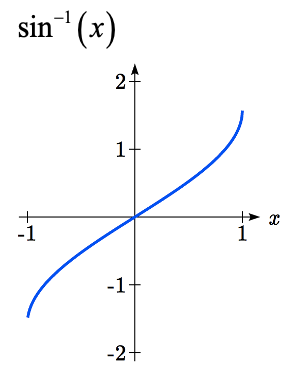
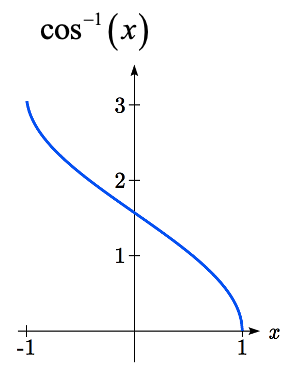
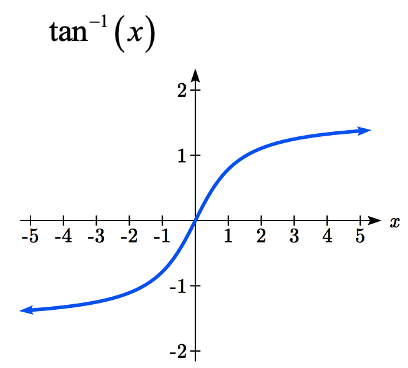
Notice that the output of each of these inverse functions is an angle.
Example 6.3.1
Evaluate
- sin−1(12)
- sin−1(−√22)
- cos−1(−√32)
- tan−1(1)
Solution
a) Evaluating sin−1(12) is the same as asking what angle would have a sine value of 12. In other words, what angle θ would satisfy sin(θ)=12?
There are multiple angles that would satisfy this relationship, such as π6 and 5π6, but we know we need the angle in the range of sin−1(x), the interval [−π2,π2], so the answer will be sin−1(12)=π6
Remember that the inverse is a function so for each input, we will get exactly one output.
b) Evaluating sin−1(−√22), we know that 5π4 and 7π4 both have a sine value of −√22, but neither is in the interval [−π2,π2]. For that, we need the negative angle coterminal with 7π4. sin−1(−√22)=−π4
c) Evaluating cos−1(−√32), we are looking for an angle in the interval [0,π] with a cosine value of −√32. The angle that satisfies this is cos−1(−√32)=5π6
d) Evaluating tan−1(1), we are looking for an angle in the interval (−π2,π2) with a tangent value of 1. The correct angle is tan−1(1)=π4
Exercise 6.3.1
Evaluate
- sin−1(−1)
- tan−1(−1)
- cos−1(−1)
- cos−1(12)
- Answer
-
a) −π2
b) −π4
c) π
d) π3
Example 6.3.2
Evaluate sin−1(0.97) using your calculator.
Solution
Since the output of the inverse function is an angle, your calculator will give you a degree value if in degree mode, and a radian value if in radian mode.
In radian mode, sin−1(0.97)≈1.3252
In degree mode, sin−1(0.97)≈75.93∘
Exercise
Evaluate cos−1(−0.4) using your calculator.
- Answer
-
1.9823 or 113.578∘
In Section 5.5, we worked with trigonometry on a right triangle to solve for the sides of a triangle given one side and an additional angle. Using the inverse trig functions, we can solve for the angles of a right triangle given two sides.
Example 6.3.3
Solve the triangle for the angle θ.
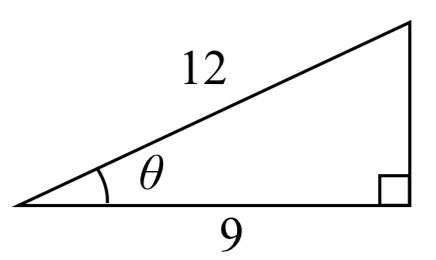
Solution
Since we know the hypotenuse and the side adjacent to the angle, it makes sense for us to use the cosine function.
cos(θ)=912
θ=cos−1(912)
θ≈0.7227, or about 41.4096∘
There are times when we need to compose a trigonometric function with an inverse trigonometric function. In these cases, we can find exact values for the resulting expressions
Example 6.3.4
Evaluate sin−1(cos(13π6)).
Solution
a) Here, we can directly evaluate the inside of the composition.
cos(13π6)=√32
Now, we can evaluate the inverse function as we did earlier.
sin−1(√32)=π3
Exercise 6.3.3
Evaluate cos−1(sin(−11π4)).
- Answer
-
sin(−11π4)=−√22.cos−1(−√22)=3π4
Example 6.3.5
Find an exact value for sin(cos−1(45)).
Solution
Beginning with the inside, we can say there is some angle so θ=cos−1(45), which means cos(θ)=45, and we are looking for sin(θ). We can use the Pythagorean identity to do this.
sin2(θ)+cos2(θ)=1
sin2(θ)+(45)2=1
sin2(θ)=1−1625
sin(θ)=±√925=±35
Since we know that the inverse cosine always gives an angle on the interval [0,π], we know that the sine of that angle must be positive, so sin(cos−1(45))=sin(θ)=35
Example 6.3.6
Find an exact value for sin(tan−1(74)).
Solution
While we could use a similar te chnique as in the last example, we will demonstrate a different technique here. From the inside, we know there is an angle so tan(θ)=74. We can envision this as the opposite and adjacent sides on a right triangle.
chnique as in the last example, we will demonstrate a different technique here. From the inside, we know there is an angle so tan(θ)=74. We can envision this as the opposite and adjacent sides on a right triangle.
Using the Pythagorean Theorem, we can find the hypotenuse of this triangle:
42+72=hypotenuse2
hypotenuse=√65
Now, we can represent the sine of the angle as opposite side divided by hypotenuse.
sin(θ)=7√65
This gives us our desired composition
sin(tan−1(74))=sin(θ)=7√65.
Exercise 6.3.4
Evaluate cos(sin−1(79)).
- Answer
-
Let θ=sin−1(79) so sin(θ)=79
Using Pythagorean Identity, sin2θ+cos2θ=1, so (79)2+cos2θ=1
Solving, cos(sin−1(79))=cos(θ)=4√29
We can also find compositions involving algebraic expressions
Example 6.3.7
Find a simplified expression for cos(sin−1(x3)), for −3≤x≤3.
Solution
We know there is an angle θ so that sin(θ)=x3. Using the Pythagorean Theorem,
sin2(θ)+cos2(θ)=1
(x3)2+cos2(θ)=1
cos2(θ)=1−x29
cos(θ)=±√9−x29=±√9−x23
Since we know that the inverse sine must give an angle on the interval [−π2,π2], we can deduce that the cosine of that angle must be positive. This gives us
cos(sin−1(x3))=√9−x23
Exercise 6.3.5
Find a simplified expression for sin(tan−1(4x)), for −14≤x≤14.
- Answer
-
Let θ=tan−1(4x), so tan(θ)=4x. We can represent this on a triangle as tan(θ)=4x1.

The hypotenuse of the triangle would be √(4x)2+1. sin(tan−1(4x))=sin(θ)=4x√16x2+1
Important Topics of This Section
- Inverse trig functions: arcsine, arccosine and arctangent
- Domain restrictions
- Evaluating inverses using unit circle values and the calculator
- Simplifying numerical expressions involving the inverse trig functions
- Simplifying algebraic expressions involving the inverse trig functions


